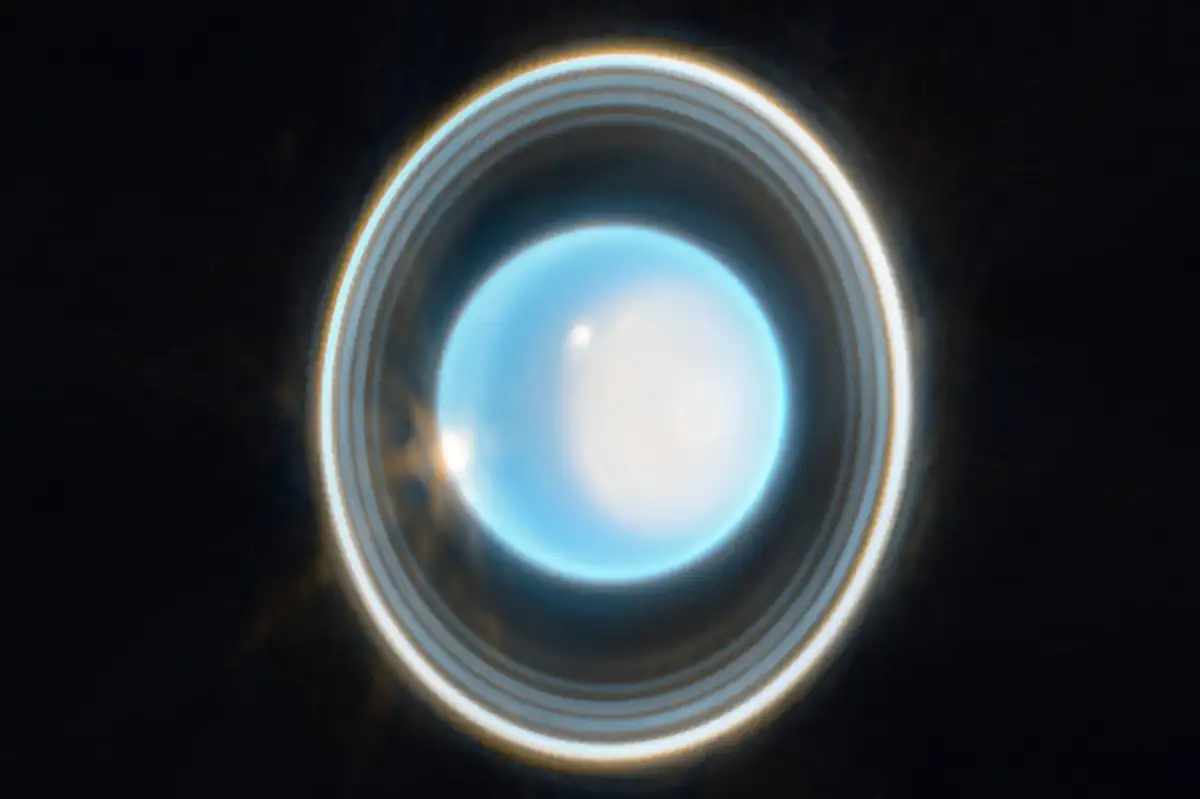The James Webb Space Telescope (JWST) has captured a breathtaking image of Uranus, revealing its rings, clouds, and a polar cap like never before. The JWST’s advanced capabilities have provided us with a detailed glimpse into the enigmatic world of this ice giant, giving scientists valuable data to further understand its composition, weather patterns, and the dynamics of its rings.
The James Webb Space Telescope: A Technological Marvel
The JWST is an engineering marvel, boasting state-of-the-art instruments designed for infrared astronomy. This cutting-edge technology enables it to capture high-resolution images of distant celestial bodies and study their infrared emissions, providing unprecedented insights into their atmospheres, structures, and origins. The telescope’s key features include:
- A large primary mirror with a 6.5-meter diameter, providing exceptional light-gathering capabilities.
- Advanced infrared instruments, including the Near Infrared Camera (NIRCam), Near Infrared Spectrograph (NIRSpec), and Mid-Infrared Instrument (MIRI).
- A highly sensitive Fine Guidance Sensor (FGS) to ensure precise targeting and stabilization.
Uranus: An In-Depth Look at Its Rings, Clouds, and Polar Cap
The recent JWST image of Uranus has allowed us to delve deeper into the composition and dynamics of this fascinating ice giant. Let’s explore each of the key features unveiled in the image.
The Rings of Uranus
The JWST image offers an unparalleled view of Uranus’ intricate system of rings. The telescope’s high-resolution capabilities have enabled scientists to study the rings’ composition, structure, and formation processes in greater detail. Here are some key findings:
- Uranus has 13 known rings, with widths varying from a few kilometers to 100 kilometers.
- The rings are composed primarily of dark, rocky particles and icy water particles.
- The inner rings are believed to be relatively young, having formed within the last 600 million years.
- The Epsilon ring, Uranus’ most massive ring, displays unique clumping of particles, which could shed light on ring dynamics and particle interactions.
The Clouds of Uranus
Uranus’ atmosphere is composed primarily of hydrogen and helium, with traces of methane that give the planet its distinctive blue-green hue. The JWST image reveals complex cloud structures and weather patterns on the planet, including:
- Bright polar clouds, possibly composed of methane ice, which indicate active weather systems.
- Darker, lower-altitude clouds made of hydrogen sulfide, ammonia, and water vapor.
- Zonal winds that reach speeds of up to 900 km/h (560 mph), generating massive storms and cloud formations.
The Polar Cap of Uranus
One of the most intriguing features revealed in the JWST image is Uranus’ polar cap. This feature is believed to be a result of the planet’s unique tilt, which causes one pole to face the sun continuously during the summer solstice. Some key observations include:
- A persistent polar hood, or cap, composed of methane ice crystals.
- The polar cap’s high albedo, indicating a high concentration of reflective particles.
- Seasonal variations in the polar cap’s size and composition, which can provide insights into Uranus’ climate and atmospheric dynamics.
Uranus’ Unique Characteristics: Tilt, Magnetic Field, and Moons
The JWST image of Uranus not only provides valuable insights into the planet’s rings, clouds, and polar cap but also sheds light on the unique characteristics that make Uranus stand out among the other planets in our solar system. Let’s explore these features in more detail.
The Unusual Tilt of Uranus
Uranus has a unique axial tilt of 97.77 degrees, which means that its poles lie almost in the plane of its orbit around the sun. This extreme tilt results in extreme seasonal variations, with each pole experiencing 42 years of continuous sunlight followed by 42 years of darkness. Some theories suggest that a massive collision with another celestial body may have caused this unusual tilt.
The Mysterious Magnetic Field of Uranus
Uranus’ magnetic field is another intriguing aspect of the planet. The JWST image, combined with previous data from the Voyager 2 spacecraft, has allowed scientists to study this magnetic field more closely. Some key observations include:
- Uranus’ magnetic field is generated by the movement of electrically conductive material within the planet’s interior.
- The magnetic field’s axis is tilted at an angle of 59 degrees relative to the planet’s rotational axis.
- The magnetic field’s center is offset from the planet’s center by approximately one-third of its radius, resulting in an asymmetrical magnetic field.
The Moons of Uranus
Uranus has 27 known moons, named after characters from the works of William Shakespeare and Alexander Pope. The JWST’s capabilities have allowed scientists to study these moons in greater detail, revealing valuable information about their composition, geology, and orbital dynamics. Some interesting facts about Uranus’ moons include:
- The five largest moons – Miranda, Ariel, Umbriel, Titania, and Oberon – are composed primarily of ice and rock.
- Miranda, the smallest of the five major moons, features a chaotic surface with large canyons, terraced layers, and a patchwork of geological features.
- The smaller, irregularly shaped moons are believed to be captured asteroids or remnants of larger moons that were shattered by impacts.
Conclusion
The James Webb Space Telescope’s breathtaking image of Uranus has provided us with an unprecedented look at the planet’s rings, clouds, and polar cap, as well as its unique characteristics, such as its unusual tilt, magnetic field, and moons. This wealth of information will undoubtedly advance our understanding of this enigmatic ice giant and its place in the solar system. As the JWST continues its mission, we can expect even more remarkable discoveries and insights into the mysteries of the universe.
Uranus has never looked better. Really.
— NASA Webb Telescope (@NASAWebb) April 6, 2023
Only Voyager 2 and Keck (with adaptive optics) have imaged the planet's faintest rings before, and never as clearly as Webb’s first glimpse at this ice giant, which also highlights bright atmospheric features. https://t.co/aE3rJIqVKy pic.twitter.com/RZElIRkudl
